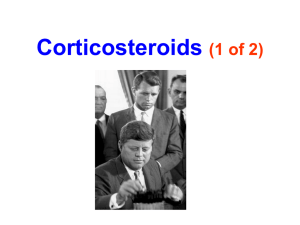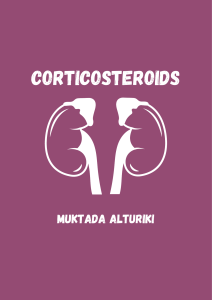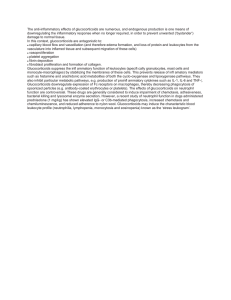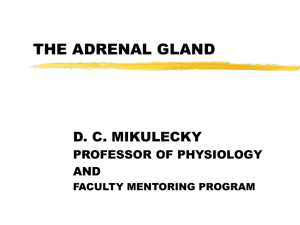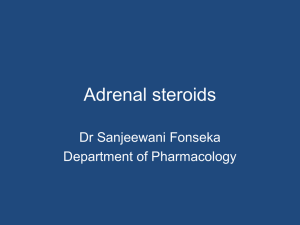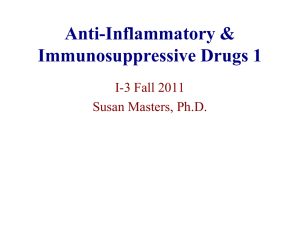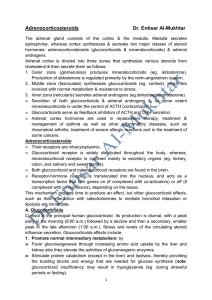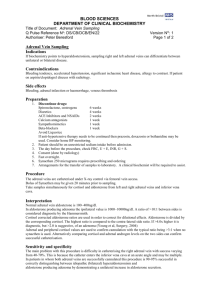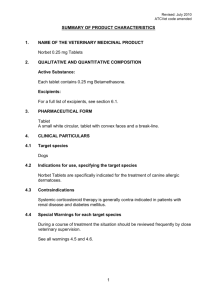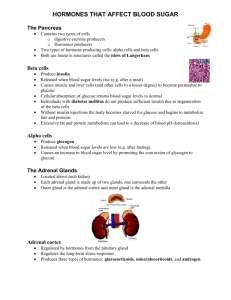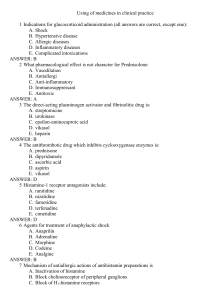Corticosteroids
advertisement
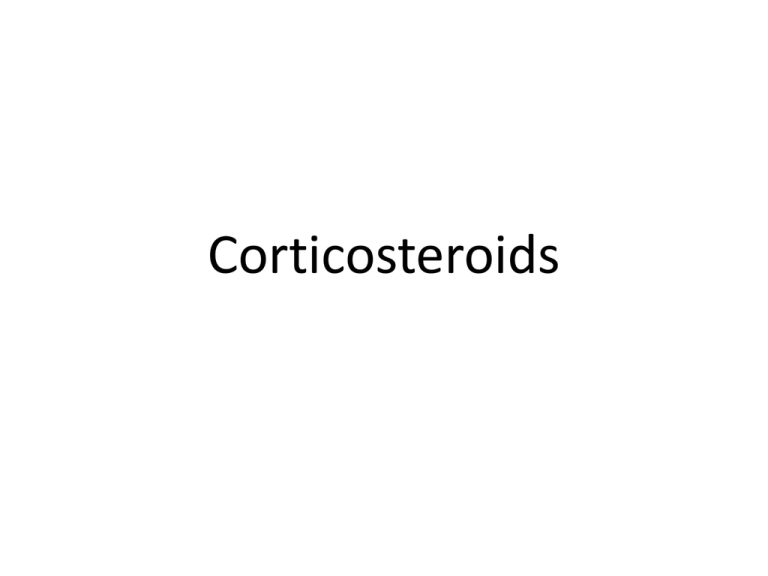
Corticosteroids Steroids: the worst drugs for adverse effects Corticosteroids History Synthesis Pharmacological Actions Uses: – Therapeutic – Diagnostic Adverse reactions Pharmacokinetics Contraindications Preparations Therapeutic principles Precautions during therapy Dosage schedule & Steroid withdrawal Glucocorticoid antagonists History 1855 – Addison's disease 1856 – Adrenal glands essential for life 1930 – Cortex > medulla 1932 – Cushing’s syndrome 1949 – Hench et al (Steroids in rheumatoid arthritis) 1952 – Aldosterone Basal secretions Group Hormone Glucocorticoids • Cortisol • Corticosterone Mineralocorticoids • Aldosterone • 11- deoxycorticosterone Sex Hormones •Androgen • DHEA •Progestogen • Progesterone •Oestrogen • Oestradiol Daily secretions 5 – 30 mg 2 – 5 mg 5 – 150 μg Trace 15 – 30 mg 0.4 – 0.8 mg Trace From Essential of Pharmacotherapeutics, ed. FSK Barar. P.351 Cholesterol ACTH Oestriol Pregnenolone 17-α- Hydroxy pregnenolone Dehydro-epi androsterone Progesterone 17- Hydroxy progesterone Androstenedione 11-Desoxycorticosterone 21,β hydroxylase Oestrone 11- Desoxycortisol Corticosterone 11,β hydroxylase 18-Hydroxycorticosterone ALDOSTERONE CORTISOL TESTOSTERONE OESTRADIOL Glucocorticoid Analogues Pharmacological Actions • Direct (Intended) Actions Anti-inflammatory Anti-allergy Anti-immunity • Permissive Actions • Lipolytic effects • Effect on bp • Effect on bronchial muscles • (e.g.,sympathomimetic amine) Pharmacological Actions • Negative feedback mechanism. • Steroids and drugs designed to mimic them are directly gene-active. • Glucocorticoids (e.g., prednisolone) used to suppress inflammation, allergy and immune responses. • Anti-inflammatory therapy is used in many illnesses (e.g., RA, UC, BA, eye and skin inflammations). -Useful in, say, tissue transplantation and lymphopoiesis (leukemias and lymphomas). • Striking improvements can be obtained, but severe adverse, but highly predictable, effects are ensue. Hypothalamopituitary adrenal (HPA) axis: Negative Immune Feedback system: Stress altered Circadian rhythm Hypothalamus CRH Anterior Pituitary Gland (-) Posterior Pituitary Gland ACTH Glucocorticoids, Adrenals Catecholamines, etc.. Kidney Muscle: Net loss of amino Acids (glucose) Liver: Deamination of proteins into amino acids, gluconeogenesis (glucose) Fat Cells: Free fatty acid mobilization Heart rate: Increased Corticosteroids are Gene-Active Pharmacological Actions • For most clinical purposes, synthetic glucocorticoids are used because they have a higher affinity for the receptor, are less activated and have little or no salt-retaining properties. • Hydrocortisone used for: orally for replacement therapy, i.v. for shock and asthma, topically for eczema (ointment) and enemas (ulcerative colitis). • Prednisolone the most widely used drug given orally in inflammation and allergic diseases. Pharmacological Actions • Betamethasone and dexamethasone: very potent, w/o salt-retaining properties; thus, very useful for high-dose therapies (e.g., cerebral edemas). • Beclometasone, diproprionate, budesonide: pass membranes poorly; more active when applied topically (severe eczema for local antiinflammatory effects) than orally; used in asthma, (aerosol). • Triamcinolone: used for severe asthma and for local joint inflammation (intra-articular inj.). Pharmacological Actions 1. Carbohydrate 8. Stomach 2. Protein 9. Blood 3. Lipid 10. Anti-inflammatory 4. Electrolyte and H2O 11. Immunosuppressant 5. CVS 12. Respiratory system 6. Skeletal Muscle 13. Growth and Cell Division 7. CNS 14. Calcium metabolism Stress and The Adrenal Glands Actions: Carbohydrate and protein metabolism Negative nitrogen balance and hyperglycemia • Gluconeogenesis – Peripheral actions (mobilize aas and – Hepatic actions glucose and glycogen) • Peripheral utilization of glucose • Glycogen deposition in liver (activation of hepatic glycogen synthase) Actions: Lipid metabolism • Redistribution of Fat • Buffalo hump • Moon face • Promote adipokinetic agents activity (glucagon, growth hormone, adrenaline, thyroxine) Actions: Electrolyte and water balance • Aldosterone is more important • Act on DT and CD of kidney – Na+ reabsorption – Urinary excretion of K+ and H+ • Addison’s disease ?? • Na+ loss • Shrinkage of ECF • Cellular hydration • Hypodynamic state of CVS • Circulatory collapse, renal failure, death Actions: Cardiovascular system • Restrict capillary permeability • Maintain tone of arterioles • Myocardial contractility Mineralocorticoid induced hypertension ?? Na+ sensitize blood vessels to the action of catecholamines & angiotensin Actions: Skeletal Muscles Needed for maintaining the normal function of Skeletal muscle Addison's disease: weakness and fatigue is due to inadequacy of circulatory system Prolonged use: Steroid myopathy Actions: CNS • Direct: – Mood – Behaviour – Brain excitability • Indirect: – maintain glucose, circulation and electrolyte balance ICP (pseudotumor cerebri) - Rare Pseudotumor cerebri (Intracranial hypertension) • • • • • • Glucocorticoids Mineralocorticoids Amiodarone Vitamin A Oral contraceptives Tetracyclines From Harrison. 15th edition, volume 1, page 435 Actions: Stomach Aggravate peptic ulcer. May be due to: – Acid and pepsin secretion – immune response to H.Pylori Actions: Blood RBC: Hb and RBC content (erythrophagocytosis ) WBC: Lymphocytes, eosinophils, monocytes, basophils Polymorphonucleocytes Actions: Anti-inflammatory • Recruitment of WBC and monocytemacrophage into affected area & elaboration of chemotactic substances • Lipocortin • ELAM1 and ICAM-1 in endothelial cells • TNF from phagocytic cells • IL1 from monocyte-macrophage • Formation of Plasminogen Activator • Action of MIF and fibroblastic activity • Expression of COX II Corticosteroids Lipocortin Phospholipids Phospholipase A2 Arachidonic acids Cycylooxygenase lipoxygenase Leukotriene PAF by lipocortin Prostaglandins, Thromboxane Prostacyclins Anti-inflammatory actions of corticosteroids Corticosteroid inhibitory effect Immunosuppressive and anti-allergic actions • Suppresses all types of hypersensitivity and allergic phenomenon • At High dose: Interfere with all steps of immunological response • Causes greater suppression of Cell-mediated immunity (graft rejection and delayed hypersensitivity) • Transplant rejection: antigen expression from grafted tissues, delay revascularization, sensitisation of T lymphocytes etc. Actions: Growth and Cell division • Inhibit cell division or synthesis of DNA • Delay the process of healing • Retard the growth of children Actions: Calcium metabolism • Intestinal absorption • Renal excretion • Excessive loss of calcium from spongy bones (e.g., vertebrae, ribs, etc) Actions: Respiratory system • Not bronchodilators • Most potent and most effective anti-inflammatory • Effects not seen immediately (delay 6 or more hrs) • Inhaled corticosteroids are used for long term control Preparations Drug Cortisol Anti-inflam. Salt retaining Topical 1 1.0 1 0.8 0.8 0 Prednisone 4 0.8 0 Prednisolone 5 0.3 4 Methylprednisolone 5 0 5 5 0 5 Paramethasone 10 0 - Fluprednisolone 15 0 7 Cortisone Intermediate acting Triamcinolone Preparations Drug Anti-inflam. Salt retaining Topical Long acting Betamethasone 25-40 Dexamethasone 30 Mineralocorticoids Fludrocortisone 10 DOCA 0 0 0 10 10 250 20 10 0 Synthesis Stimuli Angiotensin II ACTH Sympathetic nervous system Part Principal product Zona Aldosterone glomerulosa Zona fasiculata Cortisol Adrenal androgens & reticularis Medulla Adrenaline & Nor-adrenaline INTERCELLULAR COMMUNICATION – THE EFFECTS OF GLUCOCORTICOIDS Stimuli Light Sound Smell Taste Touch Sense Organs Other Brain Hippocampus Centers [-] [-] Hypothalamus [-] Nervous System Pituitary [-] Thyroid Nerves of the CNS and ANS Thymus Gland [-] Gonads Endocrine System Adrenal Cortex [-] Glucocorticoids Immune System Other Immune System Centers [+] Thymosin From thymus Interleukin-1
